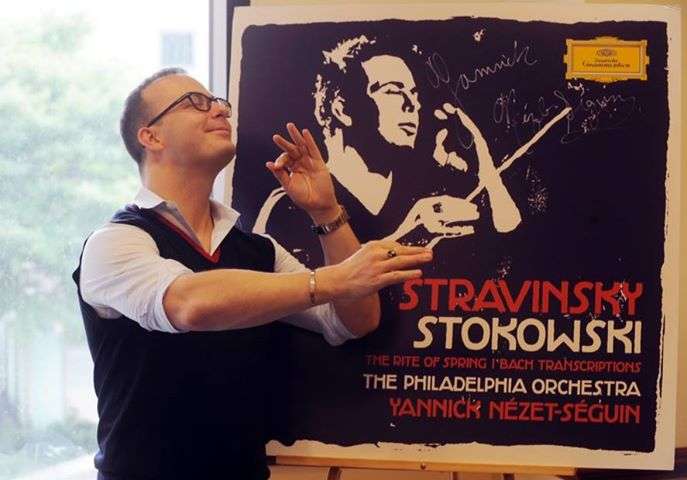|
Back
Sparkling Britten, static Strauss, blooming Mahler Philadelphia
Verizon Hall
10/04/2013 - & October 5*, 6, 2013
Benjamin Britten: Variations and Fugue on the Theme of Purcell, opus 34
Richard Strauss: Oboe Concerto
Gustav Mahler: Symphony No. 4
Christiane Karg (soprano), Richard Woodhams (oboe)
The Philadelphia Orchestra, Yannick Nézet-Séguin (conductor) 
Y. Nézet-Séguin (Courtesy of the Philadelphia Orchestra)
The Philadelphia Orchestra had to scrub their New York season opening performance Oct. 2 in Carnegie Hall because of a stagehand strike. It was cancelled the day of the performance, but the orchestra immediately arranged a pop-up concert in Verizon Hall in Philly with an informal program of Mozart and Tchaikovsky. Their regular season resumed later that week with conductor Yannick Nézet-Séguin continuing to put his imprimatur on the Mahler symphonies.
Nézet-Séguin opened the concert with Benjamin Britten’s Variations and Fugue on a theme by Purcell, an instant crowd-pleaser that is usually accompanied with the narration of “A Young Person's Guide to the Orchestra”. Nézet-Séguin removes the spoken narrative and makes it more than a showpiece. The glittering opening gave way to vivid striation in the strings and charging percussion that gets immediately to the baroque core of the work. The buoyancy of Purcell’s structure fused with Britten’s time-travel musical voicing. Nézet-Séguin calibrates this from every angle, while keeping the orchestral crosscurrents thrillingly translucent.
Next was Strauss’ Oboe Concerto with celebrated virtuoso Richard Woodhams. Nézet-Séguin is a Strauss enthusiast, but this piece strikes one as more like a conservatoire tutorial to display technical skill and Woodhams, atypically, was having an off night. The piece also begs for the soloist to bring interpretative strengths to it, if not warmth. Woodhams struggled from the start, and repeatedly had to check chambers on his oboe in the first half of the piece, once just barely resealing it before his cue. The orchestral interlocks were muddy at best, and in spots completely disengaged from his performance. Woodhams played the solo allegro toward the end with complete authority, which rescued it to an extent, but this was a very sweaty performance overall. The audience nonetheless gave him a partial standing ovation, no doubt a tribute to his distinguished tenure as lead oboe with the orchestra.
There was also a chilly quality to the first movement of Mahler’s Symphony No. 4. Those sleigh bells and glittering orchestral effects meant to conjure magical music for a childhood heaven didn’t appear at this performance. The orchestra sounded heavy and rote, even with Yannick very dancey on the podium. A little blood started to flow in the second movement, but still at a cloying pace. Then, the serene and lustrous character of the third movement bloomed full out, Nézet-Séguin’s pacing giving Mahler’s architecture immediacy on its exploratory path. His reading of the last two sections of the piece is instructive in striking a parallel with Mahler’s innovative, groundbreaking Symphony No. 6, the progressions, for instance, opening up chromatic streams prescient to jazz structures and modernism.
As Christopher Gibbs writes in his program notes, the 4th it is full of instrumental ideas. Among the outstanding players was Jennifer Montone with earthy and ethereal French horn. Also notable was the shimmering exchange between Jeffrey Khaner’s flute, David Kim’s violin and the raining harp cascades from Elizabeth Hainen. Placed next to Hainen at the back of the orchestra, soprano Christiane Karg’s gold-centered soprano sang the famous Das Himmlische Leben(“Heavenly Life”), the musical seed from which this orchestral vine grows.
Lewis Whittington
|